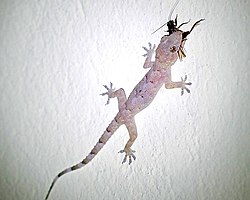Top Qs
Timeline
Chat
Perspective
Tropical house gecko
Species of gecko from sub-Saharan Africa (Hemidactylus mabouia) From Wikipedia, the free encyclopedia
Remove ads
The tropical house gecko (Hemidactylus mabouia), also called the cosmopolitan house gecko, is a species of lizard in the family Gekkonidae. The species is native to sub-Saharan Africa. However, it is also found in North, Central and South America and the Caribbean, where it has been inadvertently introduced by humans.[3][4]
Remove ads
Description

The tropical house gecko has an average total length of 10–12.7 centimetres (3.9–5.0 in) (including tail)[5] and an average mass of 4.6 grams (0.16 oz). Females are on average somewhat larger than males, with the male average snout-to-vent length (SVL) being 51.56 mm (2.030 in) and the female average SVL being 54.47 mm (2.144 in).[6] Normally coloured in black and brown bands, this gecko can slowly change its colour based on its ambient temperature and lighting; its scales vary in colour from dark brown to light grey. The tropical house gecko bears particularly scaly lamellae on the underside of its toes, enabling it to grip onto vertical surfaces.[6]
Remove ads
Diet
The diet of H. mabouia is varied, and includes animals such as isopods, centipedes,[6] spiders, scorpions, cockroaches, beetles,[6] moths, flies, mosquitoes,[7] snails, slugs, frogs, anoles, other geckos and blind snakes, with the most important element being Orthoptera species.[8]

Vocalisation
As with many gecko species, H. mabouia has the ability to vocalise. Its vocalisations range from quiet peeps to rapid short squeaking sounds.[citation needed] The vocalisations may be heard most easily on a quiet night when sitting near an open window.
Habitat
The tropical house gecko can be found predominantly in urban locations.
Behaviour
The tropical house gecko is mainly nocturnal and a voracious hunter of nocturnal flying and crawling insects. It has learned to wait near outside wall-mounted lighting fixtures so as to catch the insects that are drawn to the light.
Human impact
In some Caribbean cultures it is considered good luck to have a tropical house gecko residing in one's home[citation needed], and eats household insect pests. However, the faeces of the tropical house gecko are approximately 5 mm (0.20 in) long, 2 mm (0.079 in) wide, and dark brown (almost black) in colour. The gecko will usually confine its faeces to one area of a home, but this can present as a problem to humans if that area of the home happens to include a pale-coloured carpet, drapes, or any other easily stained surface. The stains are not easily removed, and the droppings have to be physically scooped up as well.[9]
Despite actually being harmless, the common house gecko or "wood slave" is considered by some in Trinidad and Tobago to be a bad omen, and to have a poisonous touch[citation needed]
Remove ads
References
Further reading
External links
Wikiwand - on
Seamless Wikipedia browsing. On steroids.
Remove ads




